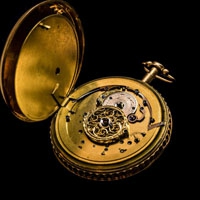一本教会你“做对”题的6级阅读书 day6 passage2
Passage 2 Medibots: The World’s Smallest Surgeons 105
世界上最小的外科医生 《新科学家》
Medibots : The world's smallest surgeons
A man lies unconscious on an operating table.
The enormous spider that hangs above him
has plunged four apparatus into his belly. The spider, made of white steel,
probes around inside the man's abdomen then withdraws one of its arms.
Held in the machine's claw is a neatly sealed bag
containing a scrap of bloody tissue.
This is a da Vinci robot. It has allowed a surgeon,
sitting at a control desk, to remove the patient's gland in a manner
that has several advantages over conventional methods.
Yet the future of robotic surgery may lie not only
with these large beasts but also with devices at the other end of
the size spectrum. The surgeons of tomorrow will include tiny robots
[01:00]that enter humans' bodies and do their work from the inside,
[01:04]with no need to open patients up or knock them out.
[01:09]While tiny robots that swim through the blood
[01:12]are still in the realm of fantasy, several groups are developing devices
[01:17]a few millimetres in size. The first generation of "mini-medibots"
[01:23]may enter our bodies through our ears, eyes and lungs, to deliver drugs,
[01:28]take tissue samples or install medical devices.
[01:33]The engineering challenges are great,
[01:35]including developing new methods of driving force and power supply.
[01:40]Nevertheless, the first prototypes are already being tested in animals
[01:46]and could move into tests on people in the not-too-distant future.
[01:51]"It's not impossible to think of this happening in five years," says Brad Nelson,
[01:57]a roboticist at the Swiss Federal Institute of Technology in Zurich.
[02:03]"I'm convinced it's going to get there."
[02:06]It was the 1970s that saw the arrival of minimally invasive surgery
[02:12]or keyhole surgery as it is also known. Instead of cutting open the body
[02:17]with large cuts, surgical tools are inserted through holes as small as
[02:23]1 centimetre in diameter and controlled with external handles.
[02:28]Some operations are now done this way, reducing blood loss,
[02:32]pain and recovery time.
[02:36]Combining keyhole surgery with the da Vinci system
[02:40]means the surgeon no longer handles the instruments directly,
[02:44]but via a computer control panel. This allows greater precision,
[02:49]as large hand gestures can be scaled down to small instrument movements,
[02:55]and any hand tremor is eliminated.
[02:57]There are over 1000 da Vincis being used in clinics around the world.
[03:04]Heart crawler
[03:06]There are several ways that such robotic surgery may be further enhanced.
[03:12]Various jointed, snake-like tools
[03:15]are being developed to access hard-to-reach areas. One such device,
[03:21]the "i-Snake", is controlled by a vision-tracking device
[03:25]worn over the surgeon's eyes.
[03:28]It should be ready for testing on patients within four years,
[03:32]says developer Guang-Zhong Yang, a roboticist at Imperial College London.
[03:38]With further advances in miniaturisation,
[03:41]the opportunities grow for getting medical devices
[03:45]inside the body in novel ways. One miniature device
[03:49]that is already tried and tested is a camera in a capsule
[03:54]small enough to be swallowed.
[03:58]In conventional test, a camera on the end of a flexible tube
[04:02]is inserted through the mouth,
[04:04]but this does not allow it to reach the middle part of the gut.
[04:09]The 25-millimetre-long capsule camera, on the other hand,
[04:13]can observe the entire gut on its journey.
[04:17]More sophisticated versions are being developed
[04:20]that can also release drugs and take samples.
[04:25]The capsule camera has no need to propel itself
[04:28]because it is pushed along by the normal muscle contractions of the gut.
[04:34]For devices used elsewhere in the body,
[04:37]some scientists are developing new mechanisms for driving force
[04:42]and power supply on a miniature scale.
[04:46]One solution is to have wires connecting the robot to a control unit
[04:51]that remains on the outside of the body.
[04:54]This is the case for a robot being developed for heart surgery,
[04:58]called HeartLander.
[05:01]Operating on the heart has always presented enormous challenges,
[05:05]says Marco Zenati, a heart surgeon at the University of Pittsburgh,
[05:10]Pennsylvania, who is one of the device's inventors.
[05:14]Conventionally the heart is stopped
[05:16]and the patient hooked up to a heart-lung machine.
[05:20]A more recent approach is to perform keyhole surgery on the beating heart,
[05:26]but even so several cuts must be made,
[05:29]and the left lung must be partly deflated to allow access.
[05:34]The HeartLander robot is designed to be delivered to the heart
[05:38]through a single keyhole cut, from where it can crawl to the right.
[05:43]The 20-millimetre-long HeartLander has front and rear foot-pads
[05:48]with suckers on the bottom, which allow it to move along like a worm.
[05:53]The surgeon watches the device with X-ray video or a magnetic tracker
[05:58]and controls it with a control stick. Alternatively,
[06:03]the device can navigate its own path to a spot chosen by the surgeon.
[06:08]The HeartLander has several possible uses.
[06:11]It can be fitted with a needle attachment to take tissue samples,
[06:16]for example, or used to inject stem cells
[06:20]or gene therapies directly into heart muscle.
[06:24]There are several such agents in development,
[06:27]designed to promote the regrowth of muscle or blood vessels
[06:31]after a heart attack. The team is testing the device on pigs
[06:36]and has so far shown
[06:38]that it can crawl over a beating heart to inject a marker dye at a target site.
[06:46]Another use would be to deliver pacemaker electrodes for a procedure,
[06:51]when the heart needs help in coordinating its rhythm.
[06:56]At the moment, the electrodes are delivered to the heart
[06:59]by pushing them in through a vein. Riviere's group
[07:03]is devising electrodes that the HeartLander
[07:06]could attach to the outer surface of the heart.
[07:10]They have tested this approach successfully on one live pig,
[07:15]and expect to start trials in people in about four years.
[07:19]Riviere says there is growing evidence to show that the technique works best
[07:25]when the electrodes are sited in certain areas
[07:28]that are hard to access from inside the veins.
[07:32]"The HeartLander can crawl around to the best position," he notes.
[07:38]While the robot could in theory be used in other parts of the body,
[07:43]in its current incarnation it has to be introduced
[07:46]through a keyhole incision thanks to its size and
[07:50]because it trails wires to the external control box.
[07:54]Not so for smaller robots under wireless control.
[07:59]One such device in development is 5 millimetres long
[08:04]and just 1 millimetre in diameter, with 16 vibrating legs.
[08:10]Early versions of the "ViRob" had on-board power,
[08:15]but the developers decided that made it too bulky.
[08:19]Now it is powered externally, by a nearby electromagnet
[08:23]whose field fluctuates about 100 times a second,
[08:28]causing the legs to flick back and forth.
[08:32]The legs on the left and right sides respond best to different frequencies,
[08:37]so the robot can be steered by adjusting the frequency.
[08:41]ViRob's developers at the Technion-Israel Institute of Technology in Haifa,
[08:47]are investigating several applications including taking tissue samples,
[08:51]delivering cancer drugs and getting a camera to hard-to-reach areas,
[08:57]such as deep within the lungs. The size of the camera is a limiting factor
[09:02]the smallest models in development are 1.5 millimetres in diameter
[09:07]but cameras get smaller every year, notes engineer Moshe Shoham.
[09:13]The team would like their device to operate inside large blood vessels,
[09:19]but it is not yet powerful enough to withstand blood flow.
[09:23]"We don't want it swept away," says Shoham.
[09:27]One application for ViRob may benefit people born with fluid on the brain
[09:33]as it may be able to extend the life of the shunts placed
[09:37]in the brain to drain the excess fluid.
[09:40]Over time such shunts tend to get blocked,
[09:44]and so need replacing every five to 10 years,
[09:48]entailing major brain surgery. Shoham says a self-cleaning shunt
[09:53]could be made by installing a ViRob permanently inside.
[09:58]In fact, if millimetre-sized devices prove their worth,
[10:03]they will attract more funding to kick-start the research.
[10:07]Small devices that do something useful will convince people
[10:11]that it's not just science fiction.
 快乐生活 2022-09-25 17:12:39
快乐生活 2022-09-25 17:12:39









